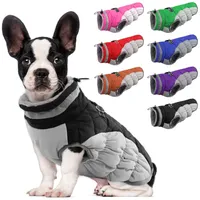Do dogs get cold? How cold is too cold for dogs in winter
Ever wondered, ‘Do dogs get cold?’ We reveal the answer, plus how to keep them warm on their winter walks.

As we head into winter, you might be questioning, ‘Do dogs get cold?’ They might have a fur coat, but our fluffy friends can still feel the cold, and some breeds might benefit from the best dog coats to keep them warm at walk time.
Just like humans, dogs can suffer from hypothermia, so it’s important to know the signs that they’re feeling too cold. These include shivering, whining, lifting their paws off the floor, lethargy, and weakness, and shouldn’t be ignored.
Walk time might be an important part of your dog’s routine, but if it’s too chilly and they start showing these symptoms, you’re better off leaving it for the day and trying some indoor exercises instead. Below, we’ve explained how cold is too cold for a dog, whether they need a sweater, and a full list of signs to look out for.
Do dogs get cold?
You would think that having all that fur would be similar to wearing a wool coat, but although fur does provide some insulation, dogs still feel the cold just as much as we humans do.
While dogs do have a body temperature that’s naturally higher than humans, they still can and will feel the cold if they’re spending long periods of time in frigid temperatures.
Some dogs are naturally better able to regulate their body temperature, but many breeds are highly affected by the freezing temperatures that many regions experience during the winter months.
Even dogs that have been bred to cope with harsh winter conditions can struggle if left outside for too long, so let’s take a closer look at the factors that influence how quickly a dog will feel the cold.
Get the best advice, tips and top tech for your beloved Pets
K&H Pet Products Thermo-Snuggly Sleeper Heated Dog Bed
This dog bed is as snuggly as they get, and we wish they came in human sizes. It has a soft foam filling, plush lining, and a 6-watt heater to keep them cozy. It automatically warms up when your dog is inside and when they’re not using it, it stays at 10 to 15 degrees above ambient temperature. You can also remove the cushion, cover, and heater when you want to wash it.
Do some dogs feel the cold more than others?
Yes, how quickly and how much a dog feels the cold is very much linked to their breed. While all dogs are individuals, there are a variety of common factors that can affect how well they do in cold weather. Here are a few things to consider with your own dog:
- Coat type: If you have a breed that was developed in the Northern Hemisphere (think Siberian Huskies, Bernese Mountain Dogs, Samoyeds, and Newfoundlands) then it’s more than likely your dog is cold-tolerant thanks to its thick, double-layered coat. But if you have a thin-coated breed like a Greyhound, Whippet, or Chihuahua, your dog will feel the cold quickly.

- Size: So here’s something you might not know - small dogs have a larger surface area to volume ratio than big dogs, meaning they have more skin through which to lose heat. If you have a small or teacup dog breed, they’ll naturally get colder faster than if you have a large breed.
- Weight: The more body fat your dog carries, the more insulation they have and the longer they’ll stay warm. Now, that’s not to say you want your dog to be overweight but it does mean that a naturally stocky breed like the Cane Corso is going to feel the cold less quickly than a lean breed like the Saluki.
- Age and health: Just like humans, younger and older dogs have a more difficult time regulating their body temperature. Dogs that are unwell will also feel the cold a lot quicker than dogs that are healthy. If your dog is in the prime of their life, they’ll likely be able to stay out slightly longer than if you have a puppy or senior dog.
While it’s worth stressing again that all dogs are unique, the above information can serve as a useful guide to the factors that can influence how well your dog copes in cold weather.
How cold is too cold for dogs in winter?
The tricky thing about cold weather is the thermostat isn’t the only thing you need to pay attention to. While the commonly held view is that cold temperatures don’t start to become a problem until they fall below 45° F, there are other factors worth taking into consideration:
- Wind chill: Have you ever had the experience of going outside into what you thought was relatively warm weather only to come back freezing because of an unexpected icy wind? Even when the temperature says it’s above 45° F, a cold breeze can cut right through your dog’s coat.
- Dampness: Whether it’s snow, rain, or fog, any damp weather can make its way through your dog’s coat and cause them to feel chilled to the bone, even if the temperature itself isn’t all that low.
- Activity: Sitting or strolling outside is vastly different from running or playing a vigorous game of fetch. Even if the temperature outside is quite cold if your dog is engaged in a lot of high-energy activities, it’s likely they’ll be generating enough body heat to stay warm.
It’s worth mentioning that temperatures under 45°F won’t be a problem for all dogs, but that’s when you may start noticing that cold-averse breeds, like Greyhounds, start to feel chilly.
Likewise, once the mercury drops below 32° F, you’ll want to start closely monitoring your dog if they’re a small breed, have a thin coat, are very young or old, or are suffering from ill-health.
By the time temperatures get below 20° F, your dog becomes susceptible to hypothermia and frostbite and they should be kept indoors wherever possible. But don’t worry, there are some great indoor games for dogs that you can play to make sure they still get their daily dose of exercise in.
Does my dog need a sweater to go outside?
A lot of pet parents wonder if they should dress their dog before taking them outside in the winter and the answer to this very much depends on the breed of dog that you have. Here are a few pointers to help you decide whether popping your dog into one of the best dog coats or rugging them up in a sweater would be beneficial:
- Coat type: Dogs with fine hair and very lean bodies need a coat in winter, even if they’re only going out for a short period of time. So if you have a Greyhound or a Whippet make sure you rug them up before taking them on their daily walk.
- Small or teacup dog breeds: Any small dog, including puppies, is best put into a coat before being taken outside to play. They aren’t able to regulate their body heat in the same way older or larger breeds are and smaller dogs are also naturally closer to the ground so their tummies are more likely to come into contact with snow.

- Health and age: If your dog isn’t in the best of health, has a weakened immune system, or suffers from a condition like arthritis, they’ll feel the cold much more easily. Older dogs fall into this camp too, so always dress them for the conditions.
All other dogs that fall outside of the above categories can generally tolerate short bursts of time outside (think 30 minutes or so) without needing a coat. You’ll also want to avoid putting a sweater or coat on thick-coated breeds, like Huskies, as this could cause them to overheat.
Lelepet Warm Dog Winter Coat
If your dog hates the cold, then they’re going to love this warm winter coat. It’s water-resistant, wind-proof, and is lined with a soft fleece. It also has a built-in harness with two D rings on the back and a reflective stripe for safety.
What are the signs that my dog is too cold?
If you’re out and about with your dog and suddenly become worried as to whether or not they might be feeling the cold, here are some signs to look out for that signal it’s time to take them back inside:
- Shaking or shivering
- A hunched posture with the tail tucked between the legs
- Whining
- A change in behavior
- Lifting their paws off the ground
- Refusing to walk any further
It’s important that you take action when you see your dog showing any of these signs and get them back home where they can warm up. If left unattended, these signs can quickly escalate and put your dog at risk of hypothermia. The tell-tale signs of hypothermia include:
- Weakness
- Lethargy in dogs
- Slow and shallow breathing
- Lack of mental alertness
- Fixed and dilated pupils
- A loss of consciousness
If you suspect hypothermia, wrap your dog up in a blanket or warm coat, get them someplace warm and contact your vet immediately.
If you’re wondering, ‘Why are my dog’s ears cold?’ and how to keep a dog warm outside or how to protect dog paws in winter, these guides have the answers.

Kathryn is a freelance writer who has been a member of the PetsRadar family since it launched in 2020. Highly experienced in her field, she's driven by a desire to provide pet parents with accurate, timely, and informative content that enables them to provide their fur friends with everything they need to thrive.
Kathryn works closely with vets and trainers to ensure all articles offer the most up-to-date information across a range of pet-related fields, from insights into health and behavior issues to tips on products and training.
When she’s not busy crafting the perfect sentence for her features, buying guides and news pieces, she can be found hanging out with her family (which includes one super sassy cat and a kitten), drinking copious amounts of Jasmine tea and reading all the books.
She has written for a range of publications, including Fit&Well, Top Ten Reviews, LiveScience, Goodto, and Product Hunt.
- Megan MilsteadStaff Writer


